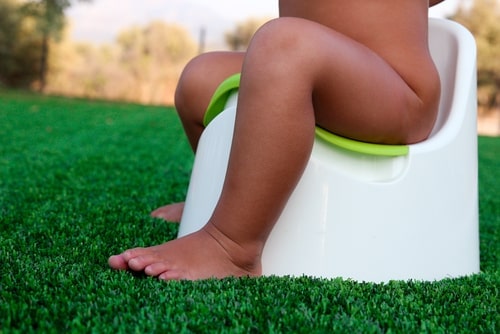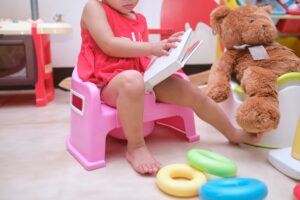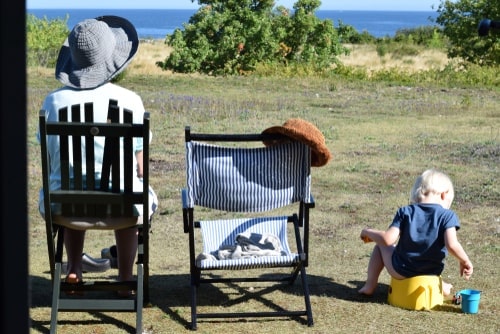“Fast track” toilet training techniques can be effective, but they aren’t right for everyone. Children shouldn’t begin unless they are healthy, motivated, and developmentally ready. And caregivers must be prepared to coach their children through hours of intensive, focused training.

To determine if fast-track training is right for your family, you need know what’s required. Here I present a detailed overview of the best-studied “fast” potty training program. At the end of the article, I also discuss a less-regimented alternative, one known as the “bare bottom method.”
If you decide you’re interested in a more gradual approach to toilet training, check out this Parenting Science guide.
Toilet training in less than a day
There are a number of different programs being promoted as “fast.” But most I’ve seen borrow heavily from the work of Nathan Azrin and Richard Foxx, two child psychologists and co-authors of the book,”Toilet Training in Less Than a Day”.
So it’s helpful to understand the general method they pioneered, a method that depends on these training tactics:
- Encouraging your child to drink lots of fluids before and during training
- Demonstrating proper toileting routines through pretend play
- Providing positive reinforcement (e.g., rewards for correct potty use)
- Prompting frequent practice drills (called “potty sits”)
- Over-correcting for accidents (i.e., guiding your child through a “potty sit” immediately after your child wets his or her pants)
What makes a child a good candidate for these toilet training techniques?
Azrin and Foxx emphasize that a child should be healthy. In particular, you shouldn’t attempt potty training if your child child suffers from diarrhea, constipation, or symptoms of a urinary tract infection.
And the program designed only for children who show certain signs of readiness.
According to Azrin and Foxx, children should be at least 20 months old, and able to
- sit up by themselves;
- walk;
- stay dry for a couple of hours at a time;
- pull a pair of loose-fitting underpants up and down by themselves;
- imitate;
- recognize a full bladder;
- point to body parts that you name;
- retrieve objects for you; and
- follow simple instructions like “put the doll on the potty.”
(For tips on boosting a child’s readiness, see this Parenting Science guide.)
It’s also important to have realistic expectations.
The title of the book (“Toilet training in less than a day”) is a bit misleading. Your child might make a breakthrough in a single session. But you will be working before that session begins. For parents, there is a substantial amount preparation. This overview isn’t intended as a substitute for reading the book and making those preparations.
In addition, this method doesn’t address bed-wetting. Nor does it eliminate the occasional daytime accident.
As I note in this article, most young children — even those who have achieved daytime dryness — experience bed-wetting until they are at least four years old.
And “daytime dryness” doesn’t mean perfection. Regardless of what potty training method you use, you should expect that your child will occasionally wet his or her pants. This is developmentally normal.
What do Azrin and Foxx’s toilet training techniques look like?

Let’s review it in three parts, beginning with the preparations you must make, and ending with two phases of training.
1. Make plans and set up your space.
- Schedule a time (4-6 continuous hours) when you and your child can focus. Be prepared to banish all distractions, including siblings and other family members.
- Choose an appropriate training area. It should be a room that is large enough to play in, and relatively easy to clean up. Azrin and Foxx suggest the kitchen.
- Gather your supplies. You’ll need a potty chair, food and drinks for your child, and a doll with a removable diaper. The authors also specify that you use a doll that can drink and “urinate” (pass water that has been poured in its mouth). However, you can probably use an ordinary doll if you are prepared to handle the special effects with sleight-of-hand.
- Dress your child in loose-fitting training pants (with nothing else over the top). Extra clothing can hinder children from pulling their pants down quickly.
- Be prepared to get your child to drink fluids. If your child isn’t thirsty, try offering him or her a salty snack. And continue to encourage your child to drink throughout the training session. You want your child to experience frequent urges to urinate, so there will be plenty of opportunities to practice using the potty.
2. Start phase one of training: Use the doll to demonstrate correct potty use.
The idea here is to engage in pretend play with your child.
Begin by offering the doll something to drink. Then tell your child needs to use the potty. Guide your child through the process of
- removing the doll’s diaper,
- sitting the doll on the potty,
- waiting for the doll to “urinate,” and
- praising and rewarding the doll for doing so.
Continue with other aspects of the routine, like emptying the doll’s “urine” from the potty chair, and washing hands.
In addition, administer frequent “dryness checks” to the doll. Ask your child: Is the doll’s diaper dry or wet?
If you determine that the diaper is dry, the doll gets another reward.
If the diaper is wet, explain that big kids don’t wet their pants. And then “over-correct” for the doll’s mistake by immediately repeating the entire potty routine — removing the diaper, sitting, waiting for urination, and providing a reward.
Azrin and Foxx suggest that you repeat the doll demonstration trials until your child understands the steps.
This usually takes no more than one hour (Azrin and Foxx 1974, p. 68).
3. Once your child shows proficiency with the doll, switch to the direct practice phase of training.
It’s time to put your child through the paces. Follow the same, familiar steps you took with the doll.
- Encourage your child to drink fluids.
- When your child is ready to urinate, help him or her sit on the potty.
- Praise and reward each successful act of urination in the potty.
- Every 15 minutes or so, ask your child if his or her pants are dry.
- If your child wets his or her pants, follow through with over-correction.
In addition, initiate practice sits. Ask your child to attempt toileting every 30 minutes or so, even if he or she isn’t feeling the urge.
What are the success rates? Do Azrin and Foxx’s toilet training techniques work?
For some reason, there has been very little research on the subject. To date, only a handful of peer-reviewed studies on “fast track toilet training techniques” have been published (Warzak et al 2016; Klassen et al 2006).
But here’s what we know.
When Azrin and Foxx tested their own method on 34 children, the average child finished training in 3.9 hours and experienced a 97% decrease in accidents the week after training. (Foxx and Azrin 1973).
Other researchers have reported less impressive outcomes, but the results are still promising.
For example, in an unpublished, dissertation study, 71 children between the age of 18 and 35 months were randomly assigned to experience either
- the Azrin and Foxx method, or
- an alternative, gradual approach to toilet training (the Spock method).
The kids trained with the Azrin and Foxx method showed earlier improvements (Candelora 1977).
Another, non-randomized study tracked outcomes for 49 children whose parents had been coached in Azrin and Foxx’s methods. The parents had attended three weekly classes. They also received phone support. On the day of children’s training, the average session lasted 4.5 hours. And the results?
Overall, about 77% of the children were sucessfully potty trained, but it depended a lot on age. Children under 25 months were more likely to struggle; 9 of the 10 kids who quit the program were in this age group. Among children over 25 months, the success rate was 93%. Eight weeks after training, kids averaged less than one accident per day (Butler 1976).
A third, much smaller study assigned children to be trained either by their own mothers or by an experienced trainer. Children experienced training in two, 4-hour sessions, and outcomes varied by condition.
Four of the 5 children trained by the practiced trainer were successful. Only 2 of the 5 kids trained by their own moms were successful. Because of the small sample size, the results were not statistically significant (Matson and Ollendick 1977).
Overall, these results suggest that Azrin and Foxx’s toilet training techniques can be quite effective. But the limited research tells us almost nothing about how fast-track methods stack up against alternative training programs.
As researchers at the University of Alberta note, more studies are needed to determine if any one potty training method is better than the rest. We also need more research to investigate
- how the individual characteristics of parents and children might affect potty training success, and
- whether or not there are any long-term, adverse side effects associated with particular toilet training techniques.
Some parents have reported that their children became upset during the training. If this happens, it’s best to back off. Pushing an upset, uncooperative child may cause behavior problems, and it certainly won’t lead to a successful toilet training outcome.
What about alternatives? Is there a way to “fast track” your child without such intensive coaching?

If the weather is nice, and you have access to a yard or patio, you might consider the “bare-bottom method.”
Pediatrician Dr. Barton Schmidt recommends this approach for children over 30 months who have already used the potty with parental assistance (Schmidt 2004). If they are familiar with the potty, but haven’t yet achieved full toileting independence, the bare-bottom method might help them make that last breakthrough.
How does it work?
According to Schmidt, you should reserve at least one six-hour block of time (or a weekend) for training. Some children might require several sessions, held on consecutive days.
For each session, strip your child below the waist and let him or her play. Offer lots of fluids to create many opportunities to urinate. Keep your child within easy access of a potty chair at all times.
And stay with your child, but do not ask your child to sit on the potty.
Be cheerful, and let him or her work things out for herself. Clean up accidents without giving any lectures or lessons. Be upbeat and affectionate.
It’s possible to attempt this method indoors, but of course it’s easier to cope with accidents if your child is outside. And wherever you hold your sessions, makes sure your child isn’t cold or uncomfortable. You want this experience to be pleasant — not stressful.
Although there are no scientific studies evaluating this approach, Dr. Schmidt reports a high success rate in his own practice (Schmidt 2004a). And similar claims have been made by psychologist John Rosemond, Ph.D..
Note: I have included a link to Amazon.com in this article. If you make a purchase using this link, a portion of your purchase will benefit this site.
References: Toilet training in less than a day
Azrin NH and Foxx RM. 1974. Toilet training in less than a day. New York: Pocket Books.
Butler JF. 1976. The toilet training success of parents after reading toilet training in less than a day. Behav Ther 7(2):185-91.
Candelora K. 1977. An evaluation of two approaches to toilet training normal children. Diss Abstr Int. 38(5-B).
Foxx RM and Azrin NH. 1973. Dry pants: a rapid method of toilet training children. Behav Res Ther 11(4):435-42.
Klassen TP, Kiddoo D, Lang ME, Friesen C, Russell K, Spooner C, Vandermeer B. 2006. The effectiveness of different methods of toilet training for bowel and bladder control. Evid Rep Technol Assess (Full Rep). (147):1-57.
Matson JL and Ollendick TH. 1977. Issues in toilet training normal children. Behav Ther 8(4):549-53.
Schmidt BA. 2004. Toilet training: Getting it right the first time. Contemporary Pediatrics, 21: 105-119.
Taubman B, Blum NJ, Nemeth N. 2003. Stool toileting refusal: a prospective intervention targeting parental behavior. Arch Pediatr Adolesc Med 157(12):1193-6.
Warzak WJ, Forcino SS, Sanberg SA, Gross AC. 2016. Advancing Continence in Typically Developing Children: Adapting the Procedures of Foxx and Azrin for Primary Care. J Dev Behav Pediatr. 37(1):83-7
Image credits for “Toilet training in less than a day? An evidence-based review of fast track toilet training techniques”
Image of child on potty chair outdoors, seen from the waist down, by shutterstock/ Saklakova
Image of child and toy bear on potties by yaoinlove / istock
Image of child using potty outside near beach by MalinBjornram / shutterstock
————————————
Brief portions of this text appeared in a previous article about fast track toilet training techniques.
Content of “Toilet training in less than a day? An evidence-based review of “fast-track” toilet training techniques” last modified 5/2020